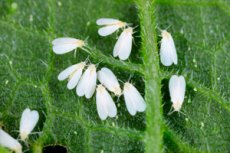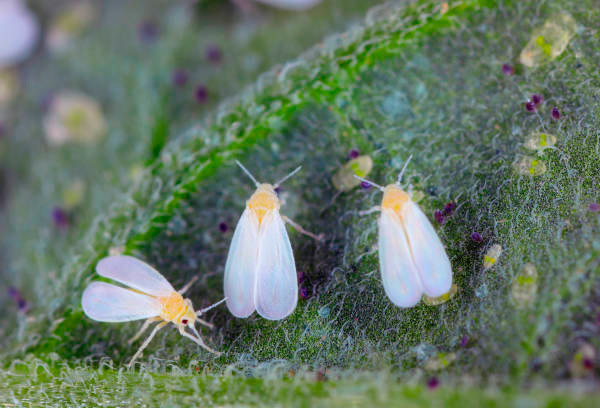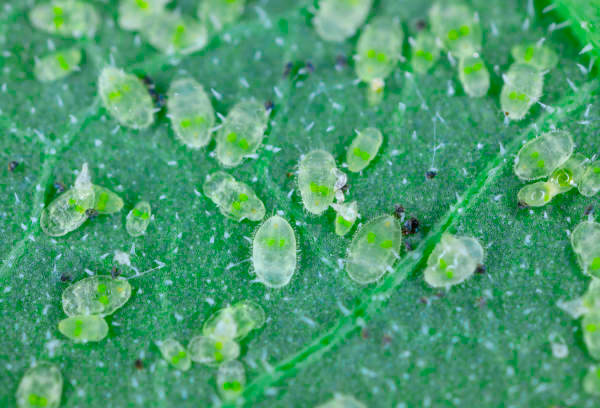Whitefly
Last reviewed: 29.06.2025

Whitefly ( bemisia tabaci) are small insects from the whitefly family (aleyrodidae) that pose a significant threat to various cultivated plants both in open fields and indoor settings. These pests feed on plant sap, leading to plant weakening and reduced yield. Additionally, whiteflies are vectors for numerous viral diseases, further deteriorating the condition of affected plants.
Significance of the topic for gardeners and home plant owners:
Understanding the biology and behavior of whiteflies is crucial for gardeners and home plant owners. Knowledge of how to identify and control these pests enables timely interventions, preventing substantial yield losses and the degradation of plants' decorative qualities.
Importance of timely detection and control of pests:
Early detection of whiteflies and the implementation of control measures are key factors in preventing the spread of diseases and maintaining plant health. Delayed action can result in uncontrolled pest population growth and the spread of viral infections, making plant recovery more difficult and costly.
What is whitefly?
Whitefly ( bemisia tabaci) are small insects from the whitefly family (aleyrodidae), representing a significant threat to agricultural crops, ornamental plants, and houseplants. These pests are widespread globally and can infest over 600 plant species, including vegetables, fruits, nuts, decorative flowers, and indoor plants.
Taxonomy and classification
Bemisia tabaci, commonly known as the whitefly, is a well-known pest species that affects a wide range of agricultural crops. Its scientific classification is as follows:
- Kingdom: animalia
- Phylum: arthropoda
- Class: insecta
- Order: hemiptera
- Family: aleyrodidae
- Genus: bemisia
- Species: bemisia tabaci
This species is widely distributed around the world and is considered one of the most important pests in agriculture due to its ability to transmit various plant viruses and its damaging feeding behavior.

Biology and life cycle of whitefly
Whitefly undergo several stages in their life cycle: egg, larva, pupa, and adult.
- Egg: female whiteflies lay eggs on the underside of leaves or in the crevices between leaves and stems. The eggs are coated with a waxy layer that protects them from desiccation and predators.
- Larva: upon hatching, the larvae actively feed on plant sap, causing tissue damage. This stage is when they are most vulnerable to control measures.
- Pupa: larvae transition into the pupal stage, undergoing metamorphosis. During this stage, they are less active and more resistant to unfavorable conditions.
- Adult: adult whiteflies begin reproducing, laying new eggs to sustain the pest population.
Signs of whitefly presence on plants
- Leaf changes: one of the earliest signs of infestation is the yellowing of lower leaves, accompanied by curling and deformation of leaf tissue. Leaves may develop brown or black spots.
- Presence of coatings and sticky residues: whiteflies secrete sugary substances known as honeydew, which attracts other pests and fosters the development of mold (e.g., powdery mildew).
- Wilting and plant weakness: infected plants begin to wilt despite regular watering, as the roots lose their ability to efficiently absorb water and nutrients.
- Presence of webbing: a thin webbing created by whiteflies can form on plants to protect their nests and retain moisture.
Impact of whitefly on plants
Whiteflies exert several negative effects on plants:
- Physiological weakening: by feeding on plant sap, whiteflies disrupt normal metabolic processes, leading to a decline in overall plant health and vitality.
- Transmission of viral diseases: whiteflies are vectors for numerous viruses, such as mosaic virus, which can severely impair the condition and productivity of plants.
- Economic losses: in agriculture, whitefly infestations result in reduced yield and quality of produce, leading to significant economic losses for farmers.
Causes of whitefly spread
- Plant movement: transporting infested plants or maintenance tools facilitates the spread of whiteflies to new areas.
- Suboptimal care conditions: overwatering, inadequate watering, improper lighting, and high humidity create favorable conditions for whitefly reproduction.
- Poor sanitation: contaminated tools and pots can transfer whitefly eggs and larvae between plants.
- Importing plants: introducing new plants, especially from infested regions, increases the risk of bringing whiteflies into uninfected ecosystems.
Methods of controlling whitefly
Mechanical methods:
- Removal of affected plant parts: carefully removing infested leaves and stems helps reduce the pest population.
- Use of traps: sticky traps attract and capture adult whiteflies, helping to control their numbers.
Chemical methods:
- Application of insecticides: specialized chemical agents effectively eliminate whiteflies. It is essential to follow dosage and application instructions meticulously.
- Safety tips for chemical use: wear protective clothing and avoid spraying insecticides on undamaged parts of the plant to prevent collateral damage.
Biological methods:
- Introduction of beneficial insects: ladybugs, lacewings, and parasitic wasps are natural predators of whiteflies and help control their populations.
- Use of biopesticides: products containing natural entomophagous agents reduce pest numbers without harmful chemical residues.
Natural and organic methods:
- Soap solutions: diluted liquid soap sprayed on plants helps kill soft-bodied insects like whiteflies.
- Neem oil and garlic tincture: these natural substances possess insecticidal properties and are environmentally friendly options for pest control.
Combined methods:
- Integration of various approaches: employing multiple control strategies simultaneously enhances the effectiveness of whitefly management and prevents the development of pest resistance.

Prevention of whitefly appearance
- Regular plant inspection: continuous monitoring of plant health allows for the early detection and elimination of infestations.
- Optimal plant care: adhering to proper watering, lighting, and temperature regimes strengthens plant immunity and reduces susceptibility to pests.
- Application of preventive measures: using insecticides or biopesticides prophylactically helps avert whitefly infestations.
- Sterilization of tools and quarantine of new plants: regularly sterilizing gardening tools and isolating new plants before introducing them to the general environment prevents the spread of whiteflies.
- Use of repellents and natural barriers: applying natural repellents like essential oils and installing physical barriers deter pests from attacking plants.
- Maintaining cleanliness and order: removing fallen leaves, debris, and other organic matter eliminates breeding grounds for whiteflies and associated pathogens.
Impact of whitefly on plants
- Deterioration of decorative qualities: yellowing, leaf deformation, flower loss, and overall plant weakening reduce the aesthetic value of plants.
- Decrease in yield: in agriculture, whitefly infestations lead to reduced quantity and quality of harvests, affecting the profitability of farming operations.
- Weakening of plant immune systems: infected plants become more vulnerable to other diseases and stress conditions, compromising their overall health and productivity.
Specific recommendations for different types of plants
- Houseplants:
- Regularly inspect plants for pest presence.
- Provide optimal care conditions, avoiding overwatering and excessive watering.
- Use natural insecticides and introduce beneficial insects to control whitefly populations.
- Ornamental plants:
- Maintain plant cleanliness and remove damaged parts.
- Employ sticky traps and biopesticides to prevent infestations.
- Ensure a balanced nutrient supply in the soil to strengthen plant immunity.
- Vegetable and fruit plants:
- Implement crop rotation and avoid planting the same species in the same location repeatedly.
- Use whitefly-resistant plant varieties.
- Regularly treat plants with insecticides and biopesticides to prevent pest spread.
- Plants in open ground and greenhouses:
- Control humidity and temperature levels to prevent favorable conditions for whiteflies.
- Install physical barriers, such as nets, to protect plants from pests.
- Introduce beneficial insects for biological control of whitefly populations.
Professional help and consultations
- When to consult experts:
- If whitefly infestations become widespread and home control measures are ineffective.
- Upon detecting pest resistance to current control methods.
- For valuable or rare plants that require specialized care and protection.
- Types of services offered by specialists:
- Diagnosis of infestation levels and identification of pest species.
- Selection and application of specialized agents for whitefly control.
- Consultation on preventive methods and optimal plant care practices.
- Choosing a specialist:
- Select qualified plant pathologists or agronomists with positive reviews and relevant experience.
- Consult official agricultural services or specialized plant protection companies.
- Verify that specialists hold necessary licenses and certifications to ensure quality service.
Conclusion
Summary:
Whitefly is a serious pest that can cause significant damage to both ornamental and agricultural plants. Understanding the biology, signs, and control methods of whiteflies enables effective population management and disease prevention.
Importance of regular care and monitoring:
Consistent plant maintenance and regular inspections help in the early detection of pests, allowing for timely eradication measures. This practice ensures the preservation of plant health and productivity while preventing economic losses.
Motivation to act:
Applying the acquired knowledge about whiteflies and their control methods empowers gardeners and home plant owners to effectively protect their plants, ensuring healthy growth and high yields. Regular monitoring, proper care, and timely control measures are essential for successful management of whitefly infestations.
Frequently asked questions (faq)
What is whitefly and how does it affect plants?
Whitefly ( bemisia tabaci) are small insect pests that feed on plant sap, causing yellowing and wilting of leaves, as well as reducing the overall vitality of the plant.
How can whitefly infestation be prevented?
Maintain proper watering and lighting regimes, regularly inspect plants, and use preventive measures such as insecticides and biological control agents.
Is it possible to completely eliminate whiteflies without chemical methods?
Yes, by using mechanical, biological, and organic methods such as manually removing pests, introducing beneficial insects, and applying natural repellents.
Which plants are most susceptible to whitefly attacks?
Whiteflies primarily affect vegetable crops (tomatoes, peppers, cucumbers), ornamental plants, and houseplants like violets and philodendrons.
What are the signs of severe whitefly infestation?
Yellowing and wilting of a large number of leaves, presence of sticky residues, and root rot are indicators of a serious infestation.
Which biological methods are most effective against whiteflies?
Introducing beneficial insects such as ladybugs or lacewings that feed on whiteflies is one of the most effective biological control methods.
How should soap solutions be properly applied to combat whiteflies?
Dilute liquid soap in water (approximately 1-2 tablespoons per liter of water) and spray the affected plants, avoiding contact with flowers and new shoots.
Can whiteflies transmit viral diseases to plants?
Yes, whiteflies are vectors for numerous viral diseases, such as mosaic virus, making them particularly dangerous to plants.
What are the environmental risks of using chemical insecticides against whiteflies?
Chemical insecticides can negatively impact beneficial insects, contaminate soil and water, and cause pests to develop resistance if misapplied.
What measures should be taken after eliminating whiteflies to restore plant health?
Provide optimal growing conditions, including proper watering, fertilization, and lighting. Regular inspections are also recommended to prevent reinfestation.
